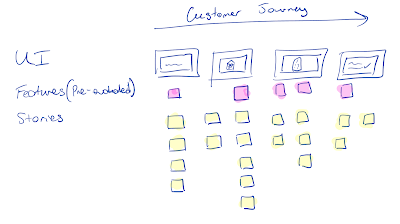The importance of story mapping
Ode to the story map...
This week i've been working through a number of features and doing a bit of a deeper dive into feature/story analysis of my current projects' minimum viable product (MVP) and how these can be placed onto a story map.
Story maps in my opinion provide a number of benefits to teams and other stakeholders in the business, such as:
- End to end vision
- Allow visual thinking
- Provoking thought
- Gain an understanding of size
- Contextualise customer journey and interaction
Story mapping is a term coined by Jeff Patton an Agilist who has written a number of blog posts and books about all things agile (i'll post some references below).
Story maps have always been a must for me, they drive conversations in the early days of the project and provide a sense of vision for everyone to see openly. They are also a great tool to run in your inception (which I will get to eventually in this blog)
I like to run my story maps with visuals (User Interface), followed by features (something that can be grouped into business process for example "Booking reminder") and then user stories (the actual work to get done for example "As a customer I want to receive an SMS reminder so that I do not miss my booking").
Placing the story map in a logical flow of user interaction from left to right is usually a good practice however, this can change if the clarity is not there for your team.
It is important to understand the best story map will be well planned and backed up by knowledge and visual design, this doesn't have to be hi-fi in any means, even a sketch will do, what ever your team can come up with.
For further reading here is Jeff Patton's Blog on The New User Story Backlog is a Map.
Happy story mapping!
